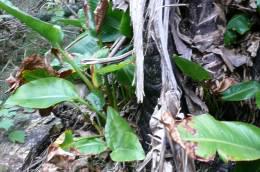Strelitzia alba
Strelitzia alba (L.f.) Skeels
Family: Strelitziaceae
Common names: white-flowered wild banana, Cape wild banana (Eng.); Kaapse witwildepiesang (Afr.); Isigude esimbalimhlophe (Nguni)
SA Tree No: 32
Introduction
Strelitzia alba is the rarest of the three large banana-like Strelitzia species occurring in southern Africa which are separated by flower characteristics and distribution. It makes an excellent focal point for a mid-size to large garden.

Description
Description
Strelitzia alba is unbranched, multi-stemmed and can grow up to 10 m tall. The older stems are woody with leaf scars and often have suckers at the base. Leaves are tufted at the apex, oblong, 2 m long, 0.4-0.6 m broad. They are leathery, opposite, green to greyish and the leaf blade tends to become torn by wind and age. The single boat-shaped flower sphathe appears in autumn to winter (May to July) and is deflexed, dark coloured, glaucous, 250-300 mm long, 60-80 mm high and about 45 mm thick.

It tapers to a slender tip with mucilage exuding over the side and on average contains five flowers. Sepals are white, 160-180 mm long and 30-35 mm broad. Petals are also white, upper petal lanceolate, 35 mm long and 10 mm broad and the lower petal boat-shaped 40-45 mm long and 10-12.5 mm broad. The filament is 30 mm long and the anthers 50-55 mm long. The fruit is a hard woody capsule that splits from the apex in summer (November to February). The seeds are round, black to brown with a yellow aril (appendage).
Conservation Status
Status
Strelitzia alba is regarded as Least Concern in the Red List of South African Plants. The author has visited the wild population a number of times since 2007 and has a different view on its status, for the following reasons: many of the suckers (small plants or clones that appear on the base of the stem) are removed by collectors; the population has no young plants or seedlings and the little seed that there is is always harvested by collectors before any of it reaches the ground to germinate.
Distribution and habitat
Distribution description
Strelitzia alba has a very limited distribution and occurs in the coastal area around the Garden Route within the Western Cape provincial boundary. It is found in protected gorges and on slopes along the rivers.

Derivation of name and historical aspects
History
Strelitzia is named in honour of Queen Charlotte, wife of George III, from the house of Mecklenburg-Strelitz. Alba, the Latin word for white, refers to the white flowers in the spathe.
The family Strelitziaceae comprises three genera: Strelitzia, Ravenala (with a single species R. madagascariensis in Madagascar) and Phenakospermum (with a single species P. guyannense in South America). Strelitzias occur in southern Africa from the Eastern Cape to Swaziland, Mozambique and Zimbabwe. There are two-tufted, clump-forming species of Stelitzia: S. reginae, with subsp. reginae and subsp. mzimvubuensis, and S. juncea. There are three arborescent species: S. alba and its close relatives S. caudata and S. nicolai.
A study by Darlington & Wylie (1955) has demonstrated that Strelitzia alba is the only Strelitzia with a different number of somatic chromosomes (2n = 22) compared to the rest in southern Africa (2n = 14).
Ecology
Ecology
There is much speculation that the pollinators may be sunbirds; however this has not been proven in this particular species.
Uses
Use
There are no known specific recorded traditional or cultural uses for Strelitzia alba.
Growing Strelitzia alba
Grow
At Kirstenbosch National Botanical Garden we have had success in propagating Strelitzia alba through division of basal suckers in autumn and winter months.

We have also had success in transplanting a 2.5 m plant at the same time as the sucker.
Hand pollination is necessary to get viable seed. Different clones should be used since the species is self-sterile or will produce very little seed when forced. The little seed we have managed to germinate we treated in the following manner: According to Alice Notten "Seed germination can be enhanced by removing the bright orange aril and soak the seed in a solution of ethrel at a concentration of 2000 ppm active constituent, for 48 hours. Sow in seedtrays filled with a well-draining soil medium at a depth of 1 to 1½ times the size of the seed. A constant temperature of 25° C is most suitable for germination, as low temperatures retard germination. Seedlings should be a good size before being transplanted (two to three leaves) into a well-draining potting medium. In our nursery we have found that the young plants are best grown in semi-shade, as the leaves tend to burn in direct sunlight. Regular repotting allows the young plant to develop rapidly. Restricting the root development retards growth" (Notten, 2002).
References
- Darlington, C. D. & Wylie, A. P. 1955. Chromosome atlas of flowering plants. 2 nd edition. London: George Allen and Unwin. P. 345.
- Dyer, R.A. 1977. Strelitzias of the Eastern Cape. The Eastern Cape Naturalist 61: 10-12.
- Germishuizen, G. & Meyer, N.L. (eds). 2003. Plants of southern Africa : an annotated checklist. Strelitzia 14, National Botanical Institute, Pretoria.
- Manning, J. 2001. Eastern Cape. South African Wild Flower Guide 11. Botanical Society of South Africa & National Botanical Institute. Cape Town.
- Pooley, E. 1998. A field guide to wild flowers of KwaZulu-Natal and the Eastern Region. Natal Flora Publications Trust, Durban.
- Notten, A. 2002. Strelitzia reginae Aiton 'Mandela's Gold' http://www.plantzafrica.com/plantqrs/strelitregmandelagold.htm South African National Biodiversity Institute.
Credits
Phakamani Xaba
Kirstenbosch National Botanical Garden
November 2010
Plant Attributes:
Plant Type: Tree
SA Distribution: Western Cape
Soil type: Sandy, Clay, Loam
Flowering season: Autumn, Winter
PH: Acid, Neutral
Flower colour: White
Aspect: Full Sun, Morning Sun (Semi Shade), Afternoon Sun (Semi Shade)
Gardening skill: Average
Special Features:
Horticultural zones










Rate this article
Article well written and informative
Rate this plant
Is this an interesting plant?
Login to add your Comment
Back to topNot registered yet? Click here to register.